Back to Robert Duncan  contents list
contents list
Robert J. Bertholf
Introduction
An Introduction to Robert Bertholf’s Robert Duncan

The young Robert Duncan, Yosemite National Park, ca. 1922
James Maynard and I selected ten poems, ten prose pieces and ten letters from the Robert Duncan Archive, The Poetry Collection, University Libraries, University at Buffalo, The State University of New York (and other holding libraries) to demonstrate the range of the materials in the Archive, and to use the materials as a way of exploring possible approaches to Duncan’s writing. Early in his writing life, for example, the theme of the longing for love permeates the poems, then the longing is afflicted with ennui and an elegiac sense of the defeat of the lover in a ruined landscape. In the 1950s, a sense of fulfillment comes into the poems which leads to songs of “praise,” but even here the tribulation of war and “a worm of scaly deeds and deaths” from the early writing persists as the contrary to love’s magic of creativity right through to the last poems in
Ground Work II: In the Dark. The Blakean contraries of love and war, the irresolvable struggle between order and strife, motivate the poems. The affliction of war comes into the poem beginning “If swarming Poetry. . . ,” and finally reaches the apex of his attention in the letters with Denise Levertov, where he risks breaking up a close friendship to maintain the integrity of views on poetic form; he takes the same risk in the letter to Clair Mahl of choosing between friendship and artistic principles. In his notebooks, Duncan struggled over his attack on Levertov’s poems long after their friendship had been broken.
Another way of thinking about the poetry emerges by tracing out the people and ideas Duncan encountered as an undergraduate at the University of California, Berkeley, 1936 — 1938 through his letters and then reading the ideas and influences out of the poetry and prose. In the first chapter of “The H.D. Book,” Duncan talks about meeting Lily and Mary Fabilli, reading James Joyce, Gertrude Stein, and Ezra Pound; he found his masters of high modernism (H.D. came in during high school, and became a central figure in the 1940s.) Lily was already engaged in politics, and left school to become a labor organizer, while Mary had a career as a writer — and later married William Everson. With Virginia Admiral he started the literary magazine
Epitaph. He would meet up with Virginia Admiral again in New York City in the 1940s, and continue with the debate between the communism of Trotsky and the communism of Stalin.
Pauline Kael was also at Berkeley, and with her Duncan read Melville’s novels, and then in the 1940s discussed the Anarchist views that he encountered at Anarchist meetings in New York. His letters to her establish that he read through
Finnegans Wake (mentioned in a letter, as is the speech “The Epic Concept of James Joyce”) and that he was reading Anarchist literature long before he attended Kenneth Rexroth’s Wednesday evening meetings of the Anarcho Pacifist Libertarian Circle. Duncan’s political stance lead him to Dwight Macdonald, who left
The Partisan Review to start the journal
Politics, where Duncan later published his essay on responsibility and freedom, “The Homosexual in Society.” The two prose pieces, “What to Do Now” and “Reviewing
View, An Attack” come from the same period as “The Homosexual in Society” and substantiate Duncan’s political position, especially against the positions of Charles Henri Ford, the editor of
View. By 1937 he was writing to James Peter Cooney who was the editor of
The Phoenix, a literary journal devoted to libertarian views and the ideas of D. H. Lawrence.
He also met Ned Fahs, his first serious lover, and left school to follow Fahs who had a job teaching at the Naval Academy in Annapolis. The break with Fahs in 1941 haunted the poetry well into the 1950s. Duncan was a liberated homosexual poet, and that stance lead him to his first mentor in poetry, Sanders Russell, whom he met at Berkeley, and with whom he edited the
Experimental Review; they carried on an intense correspondence about poetics and how to live the life of a poet. And Duncan carried on intense discussions with himself about poetics and the literary life as the selections from notebooks 1954 and 1955 confirm. The later letters of Duncan to Chris Edwards confirm Duncan’s dedication to his principles of personal freedom and the high integrity of his poetics.
Clair Mahl, Robin Blaser and Charles Olson were not at Berkeley 1936 — 1938, but in the letters to them Duncan displays the same principles of responsibility to poetry and freedom that appear in the letters to the people who were there. Olson and Duncan provoked one another, in a positive sense, forcing one another to stretch their views to accommodate a new poetics of information. Duncan gives some background to his relationship with Olson in the prose piece “Black Mountain College.” Blaser, Duncan and Jack Spicer were confederates of poetry, and in the late 1940s worked out the principles of “serial form” which is a major contribution to contemporary poetry. The two poems from that period, “Sorrow for a Friend’s Rejection Anger for Accusation” and “A Fresh Start,” show the concerns of a company of poets working toward a new poetics. The three poets were also friends, so the letters have comments about the various scenes, comments which turn into the facts of literary history. For Duncan, as for his correspondents, the letter was a vital medium of communication.

Robert Duncan at home
San Francisco, 1983
The Duncan Archive at Buffalo:
Duncan wrote in notebooks, then “re-visioned” his poems and prose when he made typescripts. He wrote in the notebooks, but also took notes on his reading, i.e. copied out passages in the traditions of a nineteenth century reader, drafted letters, and made lists of books to read, as well as recorded linguistic exercises. Published poems often appear first as sketches, which Duncan copies over and expands, at times in several notebooks, until they are ready for typing. The texts exist, therefore, for still another approach to the poems: genetic criticism of the poems, and the prose, for that matter. There are 73 notebooks, plus 5 notebooks for “The H.D. Book.” (The early notebooks are in The Bancroft Library). Duncan was a typist, so there are about 4,000 typescript pages, many with changes in his hand. Correspondence from other poets and writers makes up a large portion of the Archive. Letters came in from Robin Blaser, Denise Levertov, John Taggart, James Broughton, Helen Adam, Joanne Kyger, and Michael Palmer, to name just a few. The Helen Adam Archive and the Michael Palmer Archive contain Duncan’s letters, so both sides of the correspondence are available. The Helen Adam Archive is particularly valuable in documenting Duncan’s fascination with the Romantic ballad, represented in this selection by the two poems “What did learned Coleridge know” and “The Master of Mandrake Park,” and by the “Preface” to “Homage to Coleridge,” a booklet that Duncan never finished despite the fine drawing Jess made for the cover. (Duncan gave his letters from Charles Olson to the Special Collections, University of Connecticut).
Duncan carefully saved his correspondence with his publishers, and with schools where he gave readings. Duncan made copies of hundreds of his letters, so these along with the letters to Helen Adam, Jess, Sanders Russell, Jack Johnson, Virginia Admiral, Gael Turnbull, and Norman Austin (as representative) enhance the archive. The archive also contains hundreds of pages of manuscripts by other writers, hundreds of photographs, hundreds of audio-tapes from readings all over the country, and two collections of tapes from Duncan’s classes at New College, San Francisco. There are hand-made cards and hand-made books with drawings, holograph poems, and collages of various kinds. The poem “Let my verse be high and dry until” was mailed out as part of a Christmas card. Posters, announcements, portraits by Jess, Harry Jacobus, and Virginia Admiral augment the collections, as do Duncan’s own crayon drawings.
Another approach to Duncan’s poetry appeared when The Poetry Collection acquired Duncan and Jess’s library. There were 255 boxes — 30 pound shipping boxes — of books, including the ones in Duncan’s reference library, and Jess’s collection of children’s books. The library is now in the process of being cataloged. While Duncan did not write in his books, the study of his sources for the poems and the reference structure of “The H.D. Book” illuminate his process of poetic thinking. With Duncan’s copies of his own publications, The Poetry Collection now has a complete first edition collection of Duncan’s publications, including first appearances in magazines and anthologies reprinting poems. The Archive, book, and magazine collections are supported, in part, by a Robert Duncan / Jess Collins endowment fund.
A News Report:
New Directions is now preparing a new edition of
Ground Work: Before the War and
Ground Work II: In the Dark in one volume. To celebrate that event The Poetry Collection will sponsor a conference on Duncan’s late poetry, 21-22 April 2006.
Follow this link:
 The Robert Duncan Conference at Buffalo in April 2006
The Robert Duncan Conference at Buffalo in April 2006
Robert J. Bertholf holds a B.A. from Bowdoin College and a Ph.D. from the University of Oregon. After teaching at Kent State University, he became the Curator of The Poetry Collection in 1979, and continued in that role until 2004. He is now Charles D. Abbot Scholar of Poetry and the Arts in The Poetry Collection. He is the author of
A Descriptive Catalog of the Private Library of Thomas B. Lockwood (1983), and
Robert Duncan: A Descriptive Bibliography (1986). He has edited Joel Oppenheimer’s
Collected Later Poems (1998), and with David Landrey Joel Oppenheimer’s columns from
The Village Voice as
Drawing from Life; he has also edited several collections of Robert Duncan’s writing including
Selected Poems (1997),
A Selected Prose (1995), and with Albert Gelpi
The Letters of Robert Duncan and Denise Levertov (2003). He is currently working on the collected writing of Robert Duncan which will begin appearing in 2007. His book
Remembering Joel Oppenheimer will appear in November 2005.
James Maynard has an M.A. in English: Creative Writing from Temple University and is a doctoral candidate in English at the State University of New York at Buffalo, where he is writing a dissertation on Robert Duncan and assisting with the editing of his collected writing.
it is made available here without charge for personal use only, and it may not be
stored, displayed, published, reproduced, or used for any other purpose
This material is copyright © Robert J. Bertholf and Jacket magazine 2005
The Internet address of this page is
http://jacketmagazine.com/28/dunc-bert-intro.html
